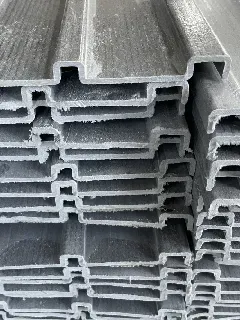loading...
- No. 9, Xingyuan South Street, Dongwaihuan Road, Zaoqiang County, Hengshui, Hebei, China
- admin@zjcomposites.com
- +86 15097380338
- Welcome to visit our website!
frp solar structure
The Emerging Role of FRP Solar Structures in Sustainable Energy
As the world transitions towards renewable energy sources, the efficiency and sustainability of these systems have become paramount. Among the innovative solutions that have emerged is the use of Fiber Reinforced Polymer (FRP) solar structures. These structures are not only revolutionizing the design and installation of solar energy systems but are also contributing significantly to the long-term viability of solar technology.
Understanding FRP Materials
Fiber Reinforced Polymer (FRP) is a composite material made from a polymer matrix reinforced with fibers. The fibers, which can be made from glass, carbon, or aramid, provide strength and rigidity, while the polymer offers protection against environmental deterioration. The result is a lightweight yet exceptionally strong material that is highly resistant to corrosion, making it ideal for outdoor applications like solar mounts and frameworks.
Advantages of FRP Solar Structures
1. Lightweight and Durable One of the key benefits of FRP is its lightweight nature compared to traditional materials like steel or aluminum. This reduced weight simplifies transportation and installation, leading to lower labor costs and quicker project completion times. Additionally, FRP structures are durable, offering a lifespan of over 25 years without significant degradation, which is essential for investments in solar energy.
2. Corrosion Resistance Electrical conductivity and corrosion resistance are critical factors in solar installations. Traditional metals can corrode over time, particularly in coastal or humid environments, leading to degradation of the solar mounting systems. FRP materials, however, are not susceptible to rust or rot, ensuring that the solar structures maintain their integrity and functionality over time.
3. Flexibility in Design FRP can be fabricated into various shapes and sizes, offering immense flexibility in design. This versatility allows for creative and efficient designs tailored to specific site conditions and aesthetic preferences. Whether horizontal, vertical, or at unconventional angles, FRP can adapt to the unique requirements of a project.
4. Reduced Maintenance Costs The longevity and resistance to environmental elements translate to reduced maintenance costs. Traditional metal structures may require regular inspections and maintenance to prevent rust and structural failure. In contrast, FRP requires minimal upkeep, allowing solar providers to focus resources elsewhere.
frp solar structure

5. Eco-friendly Material As the world strives for sustainable solutions, the eco-friendliness of materials used in solar installations has become increasingly important. FRP structures can be manufactured with recycled materials and can themselves be recyclable in some formulations, contributing to a circular economy approach in renewable energy resource management.
Applications of FRP in Solar Energy Systems
FRP is finding varied applications in the solar energy sector, from mounting structures to embedded elements in solar panels. Solar mounting systems—those frameworks that hold solar panels in place—are adopting FRP for both ground-mounted and rooftop systems. Its lightweight nature reduces the structural load on buildings, making it suitable for installations where traditional materials might be impractical.
Additionally, FRP is being used in the development of floating solar farms. As land becomes increasingly scarce, floating solar technology is emerging as a viable alternative to traditional ground-mounted systems. The buoyancy and corrosion resistance of FRP make it an ideal candidate for these innovative floating structures.
Challenges and Future Prospects
While FRP solar structures present numerous advantages, challenges remain. The initial costs of FRP materials can be higher than those of traditional materials, which may deter some initial adopters. However, as technology advances and production scales, these costs are expected to decrease.
Looking forward, the integration of FRP with next-generation solar technologies—such as solar skins and flexible solar panels—could transform how we harness solar energy. The continuous innovation in the material properties, along with the growing emphasis on sustainable solutions, suggests a promising future for FRP in the solar energy landscape.
Conclusion
The emergence of Fiber Reinforced Polymer solar structures marks a significant step forward in the quest for effective and sustainable energy solutions. With their lightweight properties, corrosion resistance, and design flexibility, FRP structures not only enhance the efficiency of solar installations but also contribute to a greener future. As the energy landscape continues to evolve, embracing such innovative materials will be crucial to meeting the growing demand for renewable energy technologies. The potential of FRP in revolutionizing solar structures is immense, paving the way for a more sustainable and environmentally friendly energy future.
-
The Rise of FRP Profiles: Strong, Lightweight, and Built to LastNewsJul.14,2025
-
SMC Panel Tanks: A Modern Water Storage Solution for All EnvironmentsNewsJul.14,2025
-
GRP Grating: A Modern Solution for Safe and Durable Access SystemsNewsJul.14,2025
-
Galvanized Steel Water Tanks: Durable, Reliable, and Ready for UseNewsJul.14,2025
-
FRP Mini Mesh Grating: The Safer, Smarter Flooring SolutionNewsJul.14,2025
-
Exploring FRP Vessels: Durable Solutions for Modern Fluid HandlingNewsJul.14,2025
-
GRP Structures: The Future of Lightweight, High-Performance EngineeringNewsJun.20,2025
